Historic Truman Courthouse
Introduction
Author-Uploaded Audio
Play when you are at the courthouse!
Text-to-speech Audio
The courthouse located at 112 West Lexington Avenue in Independence served as one of the two sites that Truman worked at while serving first as eastern district judge from 1922-24, and then as presiding judge from 1926-34 in Jackson County. The first courthouse was constructed in 1836 and has been remodeled multiple times since. Truman oversaw the 1933 remodeling of the courthouse in the colonial revival style. Today the courthouse serves as the home of the Jackson County Historical Society. They provide guided tours and historical interpretation. In addition to that, they also operate a History Center, an Archives and Research Center, the Old Jail, a gallery of George Caleb Bingham paintings, and Harry S. Truman's office and courtroom. The courthouse also now houses offices for Jackson County’s Assessment, Collections and Recorder of Deeds Departments, as well as the Independence Tourism Department. In 1912, the courthouse ground's were chosen by the Missouri Chapters of the Daughters of the American Revolution as the location for one of 29 granite markers to trace the route of the Santa Fe Trail through the State of Missouri. It honors the role of Independence in the history of the trail.
Listen to the audio to learn more about Harry S. Truman's early political life!
Images
The Jackson County Courthouse. An equestrian statue honoring General and later President Andrew Jackson sits in front. To the left is a marker honoring the Oregon Trail. The Daughters of the American Revolution Santa Fe Trail marker is to the right.

Truman Historic courthouse during recent renovations
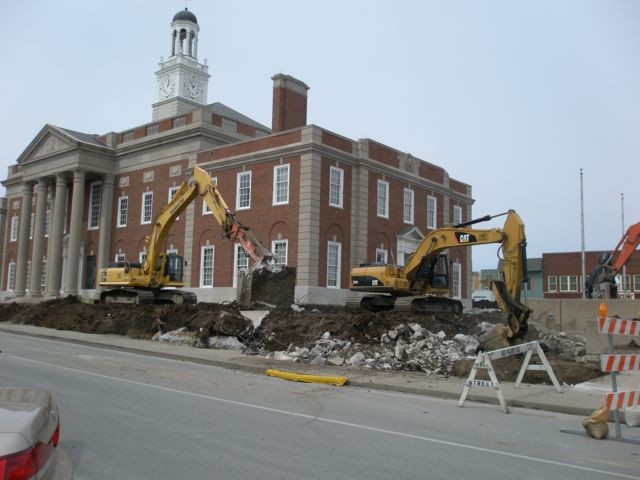
The original Jackson County, Mo. Courthouse built in 1827. It was used by the county up until 1932 and today is a historic site.

Reproduction of an engraving of the first Jackson County courthouse in Independence, Missouri, probably dated around 1844.
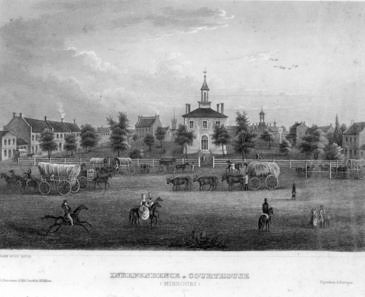
Jackson County Courthouse ca 1900
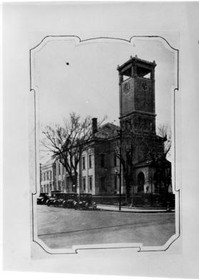
Jackson County Courthouse 1960
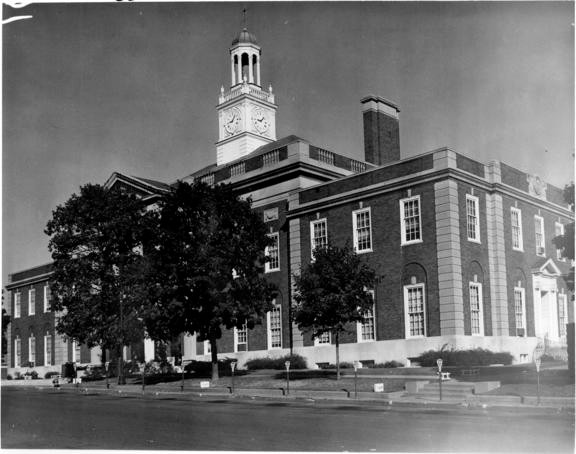
Jackson County Presiding Judge Harry S. Truman is speaking at the dedication of the Jackson County Courthouse in Independence, Missouri in 1933.
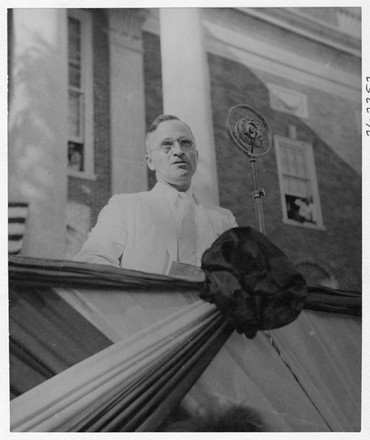
President Gerald Ford speaks at the dedication of the Harry S. Truman statue in front of the Jackson County Courthouse in Independence, Missouri.
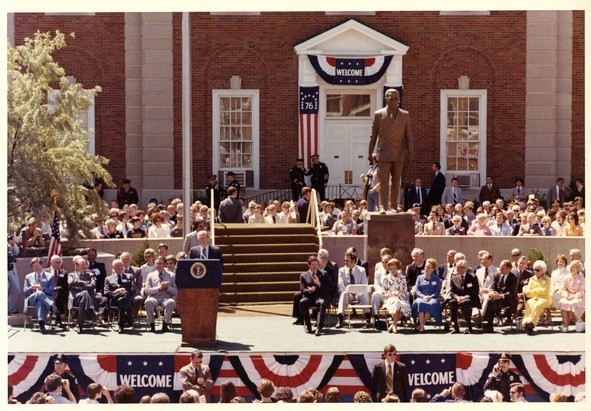
The Santa Fe Trail Marker at the Jackson County Courthouse in Independence, Mo.

Backstory and Context
Text-to-speech Audio
The County of Jackson, named for General Andrew Jackson, hero of the Battle of New Orleans in the War of 1812, was formed in 1826. The town of Independence was founded the following year and was chosen to be the county seat of the new Jackson County. The first county courthouse was built that same year, a humble log structure costing $150. Independence quickly became a center of trade on the Santa Fe Trail. Since it was much closer to Santa Fe than earlier starting points such as Franklin and Fort Osage, it quickly became the main jumping off point for wagon trains headed west. The destruction of the original main outfitting town, Franklin, in 1828 by flooding hastened the rise of Independence. Steamboats unloaded wagons and cargo at the river landing to the north and Independence soon became a boom town filled with stores, blacksmiths, wagon makers, saddle makers and all the other types of businesses needed to outfit trading missions, which could contain over a hundred wagons. Eventually wagons headed for California, Oregon and other points west would start in Independence. As the city grew and prospered, the county built a permanent courthouse at this location on the town square in 1836. The county has since rebuilt or remodeled it five times.
The county constructed the current courthouse in 1933 thanks to the effort of the Presiding Judge of Jackson County Harry Truman. Truman not only lobbied for funding for its construction but had personally traveled the country looking at courthouses for inspiration and many of his ideas were incorporated into the final design and decoration of the building. Truman made his name in politics while serving as judge of Jackson County. As a county administrator, Truman improved county finances, built a county road system, and oversaw the construction of a county hospital. Truman’s tenure as county judge provided the foundation for his future political career as a U.S. Senator, Vice-President, and later as President.
According to Edgar Hinde, Truman friend and former postmaster for the City of Independence, Truman, “was a power in politics around here. Because everybody respected Truman. They knew he was absolutely honest and everybody had a lot of respect for him. He ran the county in the proper manner and he conducted himself in the same way. He had a lot of power, I'll tell you. He had a lot of followers.” This quote shows the importance and success of Truman at home and beyond and it sums up some of the strengths of his character. For these reasons and more, the courthouse has also become a symbol for many politicians trying to associate themselves with Truman. Many presidents have also given speeches on the courthouse steps.
In 1912, the Missouri Chapters of the Daughters of the American Revolution chose the Jackson County Courthouse grounds in Independence as the location for one of 29 granite markers to trace the route of the Santa Fe Trail through the State of Missouri. It honors the role of Independence in the history of the trail. The DAR chose this courthouse as well as the Lafayette County Courthouse in Lexington and the Saline County Courthouse in Marshall as locations for the markers knowing that they would be most visible there and also would be cared for as part of the courthouse grounds. It was installed in 1912 but was formally dedicated on May 15, 1913 by a delegation of the Kansas City DAR, who travelled in a 15-car caravan from the last marker in New Santa Fe, Mo. on the Kansas Border to New Franklin, Mo. the site of the first marker. Along the way they dedicated each of the 29 markers.
History of the Missouri DAR Santa Fe Trail Markers
From 1906 to 1907, as the work of the Kansas Chapters of the Daughters of the American Revolution that traced the route of the Santa Fe Trail in Kansas was making national news, the Kansas City chapter of the organization began discussing ways they might memorialize the trail's route in Missouri. The Kansas City DAR chapter had already commissioned one stone in 1905 to mark the trail route as it passed through Penn Valley Park. Following that work, they proposed placing a series of red granite markers, similar to the ones in Kansas, to trace the trail from its origin in Old Franklin, Missouri, to the town of New Santa Fe on the Kansas/Missouri state line.
At the state conference in October 1908, a motion was made that the Missouri DAR chapters would work together on the project. A committee of members from Kansas City was delegated to manage the project and choose the markers' locations. The head of the committee was Hope Van Brunt, whose husband John was the Kansas City architect who had designed the marker in Penn Valley Park.
The Kansas City DAR began by compiling available sources to map the original route of the trail, much of which had been forgotten. They consulted maps from early Missouri and spoke to “old settlers” who had once worked on the trail and could suggest historic locations to mark. By February 1909, their map was complete, and they had picked out 34 locations of historical significance along the trail where they wanted to place markers. They now began lobbying the Missouri State Legislature for $4000 to fund the project. A year later, the legislature took up the proposal and appropriated $3000 for the project. However, bureaucratic delays prevented the money from being released, and the appropriation expired. The legislature appropriated the money again in March 1911, and after another year’s delay, the DAR was finally able to order the markers.
In July 1912, a delegation of Kansas City DAR members traveled the route of the Santa Fe Trail in Missouri and placed stakes at 33 historic locations they wished to mark. In the end, the DAR was able to place 29 markers. The markers are made of Missouri Rose Granite from the Saint Francois Mountains in southeast Missouri. They each weigh over a ton. Several arrived in 1912 and were placed in Independence, Arrow Rock, and Old Franklin. The rest were installed and dedicated in May 1913.
Sources
1. "Jackson County Courthouse, Independence." Harry S. Truman Presidential Library & Museum. Accessed August 18, 2017. https://www.trumanlibrary.org/places/in21-22a.htm.
2. "Oral History Interview with Edgar Hinde." Harry S. Truman Presidential Library & Museum. Accessed August 18, 2017. https://www.trumanlibrary.org/oralhist/hindeeg.htm
Holmes, M. Patricia. "Jackson County Courthouse." National Park Service - National Register of Historic Places Nomination Form. October 18, 1972. https://catalog.archives.gov/OpaAPI/media/63819272/content/electronic-records/rg-079/NPS_MO/72000713.pdf.
McCullough, David. Truman. New York, New York: Simon & Schuster, 1992.
Pasley, Jeffrey L. “Big Deal in Little Tammany: Kansas City, the Pendergast Machine, and the Liberal Transformation of the Democratic Party.” In Wide-Open Town: Kansas City in the Pendergast Era, edited by Diane Mutti Burke, Jason Roe, and John Herron, 32–56. University Press of Kansas, 2018.
"The Truman Courthouse." Accessed August 18, 2017. Jackson County Historical Society. http://jchs.org/truman-courthouse.
Truman, Harry S. Letters Home: By Harry Truman. Edited by Monte M. Poen. Columbia, MO: University of Missouri Press, 2003.
Photos: Harry S. Truman Presidential Library & Museum
https://www.trumanlibrary.org/photographs/view.php?id=29358
https://www.trumanlibrary.org/photographs/view.php?id=28756
https://www.trumanlibrary.org/photographs/view.php?id=18105
https://www.trumanlibrary.org/photographs/view.php?id=54158
https://www.trumanlibrary.org/photographs/view.php?id=57675
“U.S., Union Provost Marshals’ Papers, 1861-1867 for Phillip W. Thompson,” Ancestry.com (https://www.ancestry.com/imageviewer/collections/2399/images/32799_258525-01472?pId=33495: accessed 7/12/2025)
"33 Monument Sites Chosen." Kansas City Journal (Kansas City, Mo.) October 30th, 1912. .10.
"For a Santa Fe Trail Marker." Kansas City Post (Kansas City, Mo.) March 4th, 1909. .2.
"Marking Santa Fe Trail." Kansas City Journal (Kansas City, Mo.) May 16th, 1913. .1.
"Honor Old Trail Marker." Kansas City Star (Kansas City, Mo.) April 27th, 1913. .7.
"30 Santa Fe Trail Markers Are Dedicated." Kansas City Post (Kansas City, Mo.) May 17th, 1913. .
"More Markers For the Trail." Kansas City Star (Kansas City, Mo.) February 12th, 1909. .2.
"Marking the Santa Fe Trail." Kansas City Journal (Kansas City, Mo.) February 13th, 1909. .3.
"The Old Trail to be Marked." Kansas City Star (Kansas City, Mo.) March 20th, 1911. .1.
Photo Courtesy of Chris Wolff
First Jackson County Courthouse, Pendergast Years website, Kansas City, Missouri Public library, accessed 7/21/2025, https://pendergastkc.org/collection/missouri-valley-special-collections-kansas-city-public-library/10011644/first-jackson-county-courthouse
Photo Courtesy of Chris Wolff
